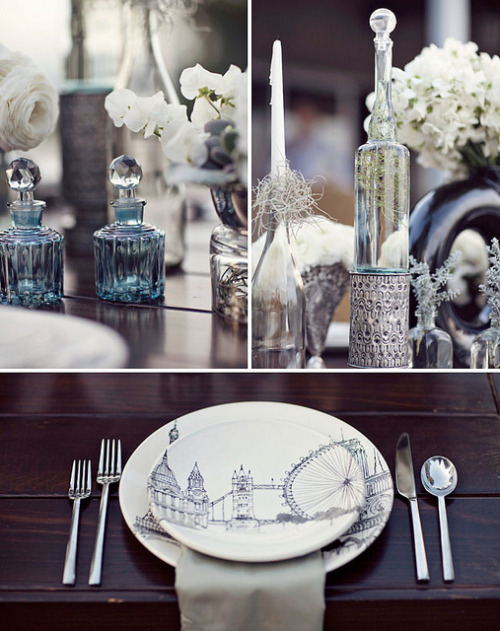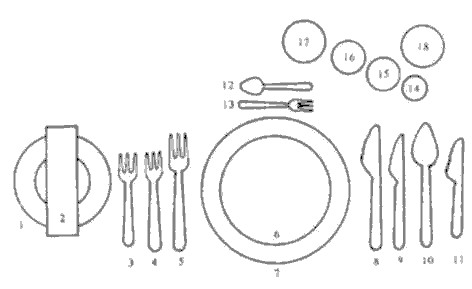ABC cutlery. LiveInternet Talk
 Happy__baby all records of the author
Happy__baby all records of the author 
 Smart_girls
Smart_girls
Cutlery - a set of tools for manipulating food directly at the table. Made from plastic, wood, aluminum, stainless steel, nickel silver or silverware. Devices made of silver and nickel silver are used in serving tables at receptions, banquets and gala evenings.
The first cutlery was a knife , which is understandable, since it was a universal item that was used in war, hunting, at the table. Over time, the knives appeared "specialization". There are several types of table knives, which are divided by purpose. They have a different shape, however, the end of all table knives is oval and blunt. This traditional form originated in the Middle Ages. It is connected with the cruel customs of those times: it was unsafe to keep pointed dagger-shaped knives on the table, since they could become a military weapon at any moment.
A table knife appears in use only in the XVI century, before that there was no difference between combat, household and table knives. A tablespoon is the most ancient cutlery after a knife. In the Russian chronicles of the XII-XIII centuries, it is mentioned as a thing habitual and necessary during the meal. Spoons and knives were made to be worn with you in special cases or simply behind the boot ankle. There are even a few sayings on this occasion: “Thrifty guest does not walk without a spoon,” “With his spoon at other people's dinners,” etc.
The most "young" cutlery is a fork . In Europe, forks (in very limited quantities) appeared in the XIV-XV centuries. Once upon a time only kings and their entourage owned forks. Ordinary people began to use the plug only in the XIX century. In the XVIII century, the fork hit Russia. It was introduced into life by Peter I. In the Russian Antiquity publication for 1824, there was the following entry: “A wooden spoon seasoned with ivory, a knife and a fork with green bone cuttings were always put in the device of Peter I, and the duty attendant was charged to wear them with him and put in front of the king, even if he happened to dine at a party. " The first forks had only two prongs and in the 18th century noble wealthy people had them.
The devices are made of chrome or nickel chrome steel. Chrome steel has a bluish tinge, and chromium-nickel - silver shine. Stainless steel appliances are also matte and finely polished. For ceremonial dinners, it is customary to serve the tables with silver and gold devices, as well as silver-plated and gold-plated ones. As a rule, these devices have delicately executed engraving decorations and stamps, on which there is an indication of the amount of the precious metal (sample).
Melchior devices are used both in everyday life and in solemn occasions. Products made of nickel silver should be treated as carefully as with silver products: they are cleaned and polished like silver.
There are:
1) basic cutlery with which they eat
2) auxiliary - collective use, with the help of which they cut, lay out or shift dishes from a common dish (salad bowls, dishes, vases, sauceboats, etc.) into the plates of the meal participants.
Modern cutlery designed for certain types of dishes and are very diverse. In household use it is not necessary to have a full set. The main thing that the devices fit the dishes in style. Appliances need to be properly maintained, and then they will always look festive and beautiful. So, devices with a wooden handle should be washed in warm water (the handle is not moistened with water) and periodically lubricated with vegetable oil, then the tree will not lose color. If food remains are left on the appliances, even those made of steel may become dull. Immediately after eating, they need to be washed and dried (wiped). Steel appliances cannot be washed in a dishwasher at the same time as appliances made from other metals (aluminum, silver), since steel can be damaged due to chemical processes. Before using the device must be polished with a towel.
There are three main sets of cutlery: a large table, snack and dessert. Each of them includes a spoon, fork and knife, but their purpose and, accordingly, sizes are different. Large or basic cutlery used when serving the first and second courses. The snack set is smaller, served for snacks of all kinds and cold dishes, as well as for some hot ones: fried ham, pancakes, etc. The dessert set is even smaller in size; It is intended for the use of sweet dishes: pudding, mousse, compote, ice cream, creams. If the broth is served in a broth cup, then put a dessert spoon on the saucer. Fruit is also served with a dessert set: a fork and a knife for fresh fruit, a fork - for fruit salads. Special fruit set is similar to dessert, but it is smaller. The fruit knife has a pointed end, and the fork has two teeth.
The so-called non-basic devices are used for fish, salad, roasts, vegetables, etc. Fish consists only of fork and knife: the fork often has four teeth, the knife has a blunt blade, having the appearance of a spatula; It is used when serving hot fish. The fish fork sometimes has the appearance of a crab claw. Her middle tooth is deeper, with its help it is easy to extract protruding fish bones. Due to the lack of a fish knife, two fish or common table forks can be served with a hot fish dish. There is also a special device for folding fish, in addition to the device for its direct use; its appearance is the same, but the dimensions are increased, the knife is exaggeratedly wide and has an almost symmetrical shape on both sides.
For the roast, two sets were also invented: for food (a large spoon and a two-toothed fork) and slicing (a sharp knife and a small fork with two teeth). Appliance for garnish includes chetyrehzatchatuyu fork and almost a round spoon, which is slightly larger than a teaspoon. The salad dressing device repeats its shape, but is larger.
There are special devices for original dishes , for example, a fork for oysters (as well as special tongs for them), a fork for crayfish, a fork for canned fish (sprats, sardines). A jug of fork is served with a cocotted fork: with three short, wide teeth. For baking offers a special fork, which has the form of a trident. In addition, there are special tongs for baking, sugar, ice, asparagus and Chinese chopsticks (they say that in some houses it is now fashionable).
A large assortment of spoons . In addition to those included in the basic sets - a device for garnish, salad and roast, fish, there are spoons for potatoes, compote, vegetables, sauce, sour cream, soup ladle, ice cream spoon (flat, in the form of a spatula), mustard, spices, salt, sugar. A potato spoon repeats the shape and size of an average potato and has characteristic ears on both sides. Spoon for vegetables exceeds the size of the soup from the main set and resembles a rather medium-sized scoop. The compote spoon is unremarkable, except perhaps a little deeper than a usual tablespoon. The soup scoop is somewhat wider. Spoon for sauce differs from it only in smaller sizes. Sour cream spoon is more round, similar to the Russian wooden spoon. Spice spoons and salt are very tiny, they are usually served on a spice rack. The sugar spoon has an unusual shape; it is flatter with a curly edge. With a slight stretch to the family of "spoon" can be attributed, and shovels for cakes and pies, caviar, fish. Tea is served with a spoon (tea), a knife and a fork for lemon, sugar tongs. The lemon knife has a zigzag blade, the fork is small, with two teeth. Coffee is served with a coffee spoon, which is slightly smaller than the teaspoon.
The group of knives is also quite numerous. The butter knife has a blunt blade, a rounded tip, two notches along the top edge. For cheese, it is almost the same, but the blade and the tip are sharper. A special knife is designed for slicing cheese and has the appearance of a wide blade with sharp cuts at the base: they need to scrape the cheese monolith, so that even thin slices of cheese crawl out of the slots. The knife for the cake resembles a medieval ax, the blade expands and rounds to the tip, and there are blunt teeth on the upper edge. Knives that have a conventional, easily recognizable appearance, are part of the main devices and appliances for roast.
There are also special tools for serving and cutting : a ladle (soup ladle), a large fork (with two teeth) and a spoon for serving roast, a slicer, a spoon for stews, potatoes, sauce, etc. The auxiliary items are tongs : dispensing tongs for baking, tongs for chopping ice, sugar, nuts and others.


1. Cutlery - used when serving the table for serving the first and second courses.
2. Dessert device: a fork for cakes and pastries, a spoon for mousses and puddings, a spoon for coffee.
3. Spoon for sugar.
4. Cheese fork knife - used when cheese is served on a table with a piece.
5. Knife for butter.
6. Fish device - used for hot fish dishes.
7. Meat forks.
8. Set for salads.
9. Spoon for sauces.
10. Spatula for the layout of cakes and pastries.
11. Pouring spoon
12. The device for the layout of the dishes on the plates.
How to arrange cutlery and dishes on the table

1 - a plate for bread, 2 - a napkin, 3 - a small fork for snacks, 4 - a fork for fish dishes, 5 - a large dining fork for meat dishes, 6 - a snack plate, 7 - a false plate, 8 - a large dining knife for meat dishes, 9 - fish knife, 10 - a tablespoon for soup, 11 - a small knife for snacks, 12 - a dessert spoon, 13 - a dessert fork, 14 - a glass for strong alcoholic beverages served to a snack, 15 - a glass for dry white wine served to fish dishes, 16 - a glass for dry red wine served to meat dishes, 17 - a glass for champagne, served about the dessert, 18 - glass of mineral water
According to the number of guests, fake plates are placed on the table, and snack bars are placed on them. Napkins, folded triangle, cap, or otherwise, put on plates. Knives put the tip to the plate. Forks put the convex side down.
Cutlery used in accordance with their location - starting with the extreme and ending with those that are next to the plate. The knife and fork are held so that the fingers do not touch the blade or teeth. If you stop using the device from time to time, put it only on the edge of the dish, but not on the tablecloth. If you have used only a fork, then the knife should rest on the right edge of the plate, where it least interferes.
If there is a pause in the meal (but the feast is not finished yet), the device is placed on the plate crosswise - the knife point is to the left, the fork is upwardly convex in part, so that the knife handle is five o'clock and the handle is - at seven o'clock. The place of crossing should fall on the teeth of the fork and a third of the knife. You can put the fork and knife handle on the table, and the other end on the plate. At the end of the meal, both devices are placed on the plate parallel to each other, their handles "show for five hours."
Glasses are served near the plate, closer to the middle of the table, parallel to its length or arc, starting to the left of the largest in size. Either the glasses are set in two rows so that the large glasses do not cover themselves smaller in size.
Plates with sliced even slices of bread are placed in different parts of the table so that all guests can easily reach it. Bread taken from common plates is placed on bread plates that are located to the left of the dummy plates.
Castors and other devices for spices are arranged at the rate of one device for three or four people.
Various cold snacks on dishes and plates are evenly placed on the table so that guests can easily get them.

